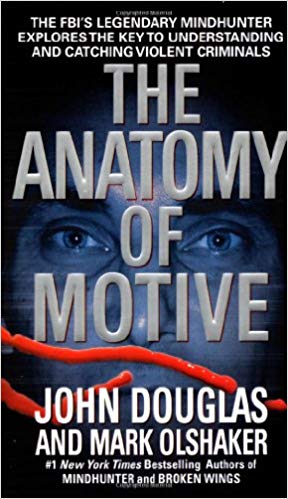“Behavior reflects personality,” says John Douglas and Mark Olshaker in The Anatomy of Motive.
And, when writing mysteries, you need to create motivation for the characters who commit the crimes in your stories, so this is a great book to read if you want to learn more about motivation and personality.
Even though each crime is unique, behavior fits into certain patterns.
Thus, the theories of motivation are an aid in recognizing criminal motivations and are key to understanding the crime and the criminal.
Juries (and readers, in this instance) want to see logical motive when they are presented with a case.
It is up to the prosecution to show this so clearly that the jury (or a reader) has no trouble finding the motive that is both logical and typical for the person in question.
It would seem that most dangerous criminals have common denominator–dysfunctional backgrounds at one level or another.
Assassin types tend to be paranoid and don’t like eye contact.
Sexual predators, have relatively high IQs, much higher than you’d expect in the general criminal population.
Motivation psychology suggests that the desire for power and control comes from a person’s background where they felt powerless and out of control.
Some children develop coping skills, others instead become angry, hostile and frustrated adults and violent offenders.
“Some men realized early on, sometimes even as very young children, that the power to manipulate others gave them a sense of control that they felt was so lacking in their lives.”
After the motivation of power comes fantasy.
A fantasy of power and control always precedes acting out.
Power is most often the motivation for sexual predators.
Arson and bombings may even be manifestations of this predator. Once again it is the power to manipulate life as they know it.
There are three youthful behaviors that together make up what has come to be known as the homicidal triad. Bed-wetting beyond an appropriate age, fire starting, and cruelty to animals or smaller children generally show a pattern that predisposes the male to criminal tendencies later on.
These are patterns but do not that mean every boy who does these will be a criminal. They are what motivation theory suggests may be early signs of potential criminal behavior.
Arson is most commonly done for insurance money, and the motive is clear, monetary profit.
Other fraud arsons have equally transparent motives, such as elimination of competition and running an intimidation or protection racket.
So again, motive is the first question a detective will ask when investigating arson.
Pyromania is defined as the uncontrollable impulse to start fires.
Unlike most violent or potentially violent crimes, this one is committed by both males and females, though their characteristics are different.
This is a fascinating study, which can improve your fiction for your murder mystery.
You can use this information to twist the scene, throw off the sleuth by planting evidence that suggests a male perpetrator, but the clues that it is female might be missed by the sleuth, but not the reader.
For further reading try this post, Anatomy of a Murder Investigation.
r.cre









